#when I used to study digital archiving and forensics there was a HUGE importance placed on drawing as a way to practice Looking
Text

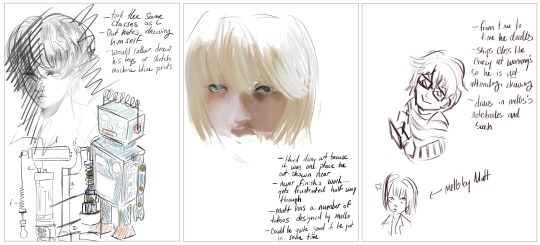
Death note characters draw themselves — inspired by @ponury-grajek and the extra bit in the manga about Misa drawing!
#death note#light yagami#l lawliet#misa amane#mello#mihael keehl#Near#nate river#Matt#mail jeevas#I love love thinking about how someone draws themselves#it says a lot#Light’s drawing of himself makes me laugh#He seems like the guy who bought one art book and learned the ‘correct’ proportions and stopped there#also Wammy’s having a rigorous art program is SO real to me#when I used to study digital archiving and forensics there was a HUGE importance placed on drawing as a way to practice Looking#We spent a few classes just drawing objects in the archiving class#and tons of bones + blood spatter + anatomy drawing work#Also L drawing Light is so intimate to me ugh the silent tenderness of what that moment would be like#also shhhhh L’s knee bone is poorly drawn shhhh you dont see it#my art
116 notes
·
View notes
Text
#LitWednesday - Larry Achiampong
We recently had a chat with British-Ghanaian artist, Larry Achiampong about his artwork and performance style.
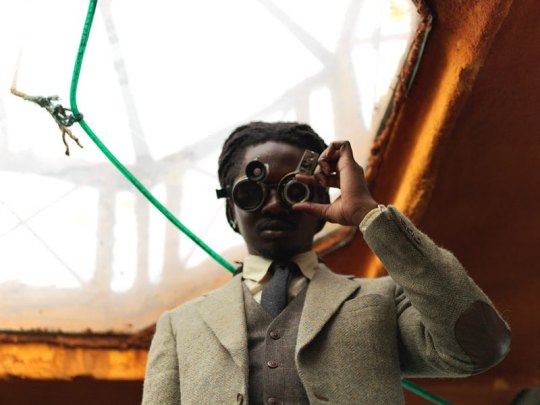
Could you please give us a brief introduction to yourself and your work?
My artistic practice involves both solo and collaborative projects that are represented in the form of installations, objects, visual or audio-based archives, live performance and sound to explore ideas that connect class, cross-cultural and post-digital identity.
I feel that the way I work is very much like a Dj or a crate-digger in that I search for histories and stories, and as a result of these findings I interweave new possibilities or versions into these moments. For example, the project ‘Meh Mogya’ (2011) is a confluence of audio samples from my parent’s record collection of Highlife Music, a sort of self-portrait that traces my Ghanaian heritage through an art form that was once used as a political tool of the nation’s pride.
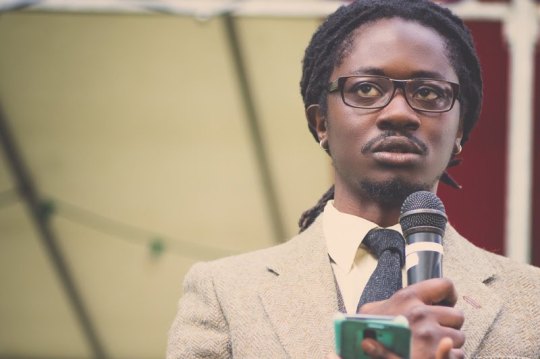
When and how did you begin the journey into live art performance?
I like to view aspects of my upbringing as having a large influence on the way I view and conceive performance works. I come from a working-class background and my mother and father used to take my siblings and I to church every Sunday. We mostly went to Ghanaian, Ashanti-Pentecostal style churches that involved infectious, bold, energy-driven testimonials from the lead pastor/s. Of course, this is hugely connected to my latest video work ‘Sunday’s Best’, but in a retrospective essence it was here that I first saw the body used as a communicative tool; hand/bodily gestures, to dance, to spoken word and so on. My uncle used to live with the family when I was a child, and he was one of the first DJs to mix Highlife music with Hip-hop into his sets. I never went to many performances, however I would be fixated on his actions when he practiced his (vinyl-only at the time) DJ sets and crafted mixtapes at home. I think that is something that people manage to really miss when it comes to DJ’s and performances…those nuances of focus between the DJ, the sounds they choose and the marriage of collaged sounds. And in my teenage years there were always friends who were building rhymes or making beats using FL Studio (Fruity Loops) or reason. This was at the height of the Garage sound, moving into Grime. People would refer to their bedrooms as the ‘studio’, and the bedroom would be turned into this space where we would pour our energy and flex that hype – that in itself had a spirit of performance to it.
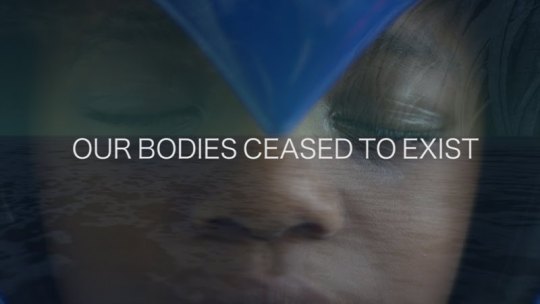
Could you please take us through Ph03nix Rising: The Mogya Project? What inspired it, and how did it come about?
Ph03nix Rising is a project that I conceived during my 2015-16 Sound & Music Embedded residency at the British Library. Following ‘Meh Mogya’ and ‘More Mogya’ and my focus on investigating sound within a Ghanaian context, I became interested in opening the framework by researching audio samples from communities across nations throughout West Africa. And so with access to the British Library’s World and Traditional Music Archive I spent time listening to a range of material - early Edwardian-era audios through to contemporary field recordings. And so similarly with the Mogya projects, I sampled and created new sounds from the archival material. Around that same time I just so happened to be playing a videogame called Xenoblade Chronicles X – a futuristic science-fictional game that involves humans setting up shop and colonising an alien planet through war and pillaging. I found parts of the story both troubling and intriguing in the same breath, but I also found that there was a relationship with the colonial context of the audios that I had sampled, and so I came up with this idea that I would use some of the visuals in this virtual landscape and couple them with the effected sounds that I had generated. This was coupled with a wordplay (that features in the video component of the performance) creates a manuscript of intergenerational colonial legacies.
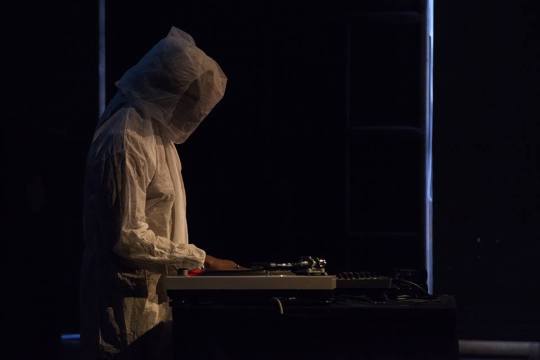
The choice to document history and identity using science fiction created an interesting contrast to the narrative of the performance. Could you please tell us more about that?
I think where my practice is situated there’s a strong marriage with research that working with performance (and the body) became a natural platform to see how the archive could be activated, especially from the point of view of identity. For example, I also wear this garb during the Ph03nix Rising performance in the form of a spit sock hood, and a disposable boiler suit. I invited this into the performance as I felt there was an opportunity for me to deal with a psychological trauma that many black people (myself included) go through. Over the years I have experienced various acts of violence inflicted by the police due to having a black body, and at the young age of 16 I was arrested because I was black. I can vividly remember a lot of the distress and even hysteria that I went through - being placed within that jail cell, alone, I tried to calm myself and I just couldn’t. Its probably the most scared I have been in my life. My clothes were taken for forensics and I was made to put on the exact type of boiler suit that I am wearing in the performance. So I am on the one hand dealing with a history that is traumatic, personal, and interpersonal, whilst at the same time contemporary, since this kind of thing (and worse) is still happening in 2017. The use of the spit sock, a primitive degrading tool of oppression in this context then becomes a no brainer – it is frequently used by law enforcement throughout the west and due to black people being disproportionately represented at all stages of the criminal justice process, situations like that which happened to Ik Aihie are going to continue.

You make numerous references to Frantz Fanon in a lot of your work. Where did the interest come from, and can you tell us more about his influence in your work, and the importance thereof?
I came across Fanon’s work during my formative years, I was doing a BA in fine art (2002-05) and you could say I was finding it really hard to fit into that environment - I was studying in a place where there were fewer working class or black people and so I didn’t feel understood on a range of levels. I had a couple of great tutors whom I would talk to about how I was feeling and Peter Owen (who co-ran City Racing gallery) recommended looking into the work of Fanon. I read ‘Black Skin, White Masks’ and immediately found a space where I could begin to locate what was happening with regards to my black body being in the crosshairs of the white gaze. So although the ‘Finding Fanon’ collaboration with David Blandy in its title is dealing with a unique perspective on Fanon’s ideas and lost writings, I would certainly say that some of my past projects and works have also been influenced by his writings. You can find such connotations in the ‘Cloudface’ motif I employ from ‘Lemme School You’ through ‘Cloud’, ‘Glyth’ and even ‘Underdog’.

Where can people access you, and your work?
You can check out my website: larryachiampong.co.uk, I’m showing work in the Diaspora Pavilion at the 57th Venice Biennale from May 13th through November 26th. I’ll soon be releasing a new audio project on vinyl, its untitled, but you can stream it here. ‘Sunday’s Best’ will be screening at the BFI this month on the 31st of March. David Blandy and myself will also be screening the entire Finding Fanon Trilogy at Tate Modern on the 24th of May.
Images: courtesy of Larry Achiampong and ICA
Larry was part of the ICA Live Art Festival in February 2017.
#litwednesday#literature#wednesday#uk#larry achiampong#performance#live performance#live art#fanon#ghana#british ghanaian#art#performance art#david blandy
1 note
·
View note